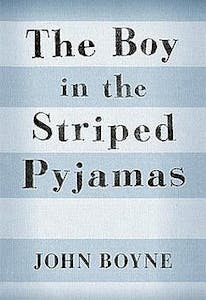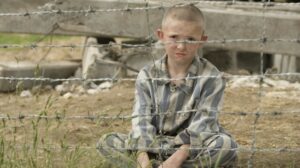John Boyne’s novel ‘The Boy in the Striped Pyjamas’ was first published in 2006 and adapted into a best-selling film two years later. It is an international best-seller and as of 2016 it had sold seven million copies. Teachers across the UK use it as a tool to teach about the Holocaust in both History and English lessons.

Many people who have read the book or watched the film adaptation believe that it is a true story based on real people and real events. However, it is important to understand that the book is a work of fiction. The events portrayed could never have happened. In this blog I outline some of the book’s historical inaccuracies and stereotypical portrayals of major characters that help to perpetuate dangerous myths about the Holocaust.
Bruno

Bruno is the main character in the book. He is a young German boy whose father, a high-ranking Nazi, takes a new job meaning the family have to move to a new place. Bruno is nine years old but doesn’t seem to be aware of the war around him, who the Jews are or even who Adolf Hitler is. As a young German boy, and the son of a senior SS officer, Bruno would have been, by law, a member of the Hitler Youth. He would have attended a German school where students regularly swore oaths to Hitler and where antisemitic propaganda infiltrated every part of the curriculum. Children were taught that the war was something to be proud of as it meant that Germany would become a great power once more.
Bruno’s characterisation perpetuates the belief that most German civilians were ignorant of what was happening around them. In fact the general public in Germany and in occupied Europe were well aware that Jewish people were being persecuted, forced to emigrate and eventually deported. There were also many who knew that Jewish people were being killed. Many Germans profited from the Holocaust as Jewish properties and belongings were ‘Aryanised’, which meant they were taken from their Jewish owners and given instead to ‘ethnic’ Germans. A minority of German civilians resisted Nazi ideology. Nazi authorities stamped out resistance to the regime quickly and brutally.
Shmuel

Shmuel is a young Jewish boy who Bruno meets whilst exploring near his new home. The first time they meet, Shmuel is behind the barbed wire of a concentration camp. Over the course of the story the two boys create a friendship despite being separated by the barbed wire fence.
As an audience we learn a lot about Bruno, so he becomes a real little boy in our imaginations. However, Shmuel is only ever depicted as a one-dimensional victim. Shmuel has no personality or individuality, so the audience doesn’t build an emotional connection with him. This means it is harder for the reader to empathise with Shmuel and his situation.
Shmuel’s characterisation portrays Jewish victims as passive and unresisting. However, Jewish resistance did exist both in and outside the concentration and death camps. At Auschwitz-Birkenau a group of Sonderkommando (Jewish prisoners forced to do the terrible work of herding people into the gas chambers, then removing the dead bodies) successfully managed to blow up one of the crematoria and kill a number of guards. It is important that people understand that Jewish people did not go to their deaths without trying to save themselves.
Shmuel’s story is also historically inaccurate. For readers of the book it is clear that the camp is probably the Auschwitz concentration camp complex as Bruno calls it ‘Out-With’. If a young boy like Shmuel had entered Auschwitz-Birkenau then it is very likely he would have been sent straight to the gas chambers on arrival, just like the majority of children who arrived there, as the Nazis didn’t consider them useful as forced labour. A small number of children were chosen for medical experimentation but these children were kept away from the main camp. Even if Shmuel had been selected for forced labour he would not have had the opportunity to spend most of his days sitting on the outskirts of the camp.
The Ending
The story’s conclusion leaves many readers upset. Bruno digs a tunnel under the wire, crawls into the camp, then he and Shmuel go looking for Shmuel’s missing father. Both boys are swept up in a group of prisoners being taken to the gas chamber, where all of them are murdered. The emotional focus of the story is on Bruno’s family and their distress as they realise what has happened to their son. The reader’s attention remains with the experience of the concentration camp commandant and his wife whose son has been killed in what is portrayed as a tragic accident.
Because the focus of the story remains on Bruno’s family, the book does not engage with the main tragedy of the Holocaust: that none of the people in the gas chamber should have been there. Due to the way in which Shmuel’s character is portrayed in the novel, his character doesn’t engage the reader’s sympathy in the way that Bruno does. Shmuel represents the 1.5 million children murdered by the Nazi regime in Auschwitz-Birkenau, in the death camps of occupied Europe and in the killing fields where millions of civilians were shot into mass graves, yet the reader’s sympathy is directed towards a Nazi concentration camp commandant and his family.

What are the alternatives?
Some educators will argue that ‘The Boy in the Striped Pyjamas’ helps raise awareness of the Holocaust in people who would not otherwise be interested, and there is perhaps some truth in that. However, in an educational context it is important however that this book is only used as a piece of fiction and that teachers make clear to young people that historically the book is not factual. There are very many survivor accounts of the Holocaust that are accessible to young people, or novels that are more accurately based in fact and less problematic from a historical and ethical point of view, that teachers could use in the classroom. Our learning programme for children and young people is based on the life stories of 16 children and young people who escaped or survived the Holocaust. Here are some of the alternative publications we suggest teachers look into.
Survivors of the Holocaust: this graphic novel by Huddersfield-based Fettle Animation is based on the real-life testimony of six survivors all of whom also feature in the ‘Through Our Eyes’ exhibition. The book was painstakingly researched but is accessible for young people. The book is based on a series of award-winning animations produced in partnership with the BBC.
When Hitler Stole Pink Rabbit by Judith Kerr: the award-winning writer and illustrator of The Tiger who Came to Tea and the Mog stories was born into German Jewish family who fled Germany in 1933 and came to the UK in 1936. This semi-autobiographical book gives a childs-eye view of the Second World War.
Hitler’s Canary by Sandi Toksvig is based on Sandi’s family experience. In Denmark the Danish population came together and were able to save the majority of Danish Jews by helping them flee to neutral Sweden or hiding them within Denmark, this is the story of one families role in the rescue.
The Diary of a Young Girl by Anne Frank is the most famous piece of writing by a victim of the Holocaust. Anne is a real child writing about her real experiences living under Nazi rule whilst in hiding in Amsterdam. There are also versions available that are suitable for primary school students.
Once by Morris Gleitzman tells the story of a young Jewish boy’s search for his parents. The novel is told through Felix’s eyes so the atrocities he witnesses in Nazi occupied Poland are told from a child’s perspective.
We have first-hand filmed survivor testimony on our website that is available to use for free, this can be found here.
Hannah May Randall
31/5/19
